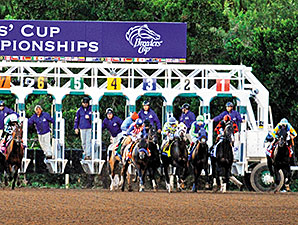Symposium: Steward Revisits BC Classic

California Horse Racing Board senior steward Kim Sawyer said having the Breeders' Cup Classic (gr. I) as the final race of the day this year created problems in publicizing the reason for the decision to take no action following the controversial race.
Sawyer was willing to sit on the hot seat and field questions following a creative panel on the final day of the Global Symposium on Racing and Gaming sponsored by the University of Arizona's Race Track Industry Program near Tucson, Ariz.
The panel showed actual stewards going through their many responsibilities by presenting a fictional scenario with a real-time countdown of minutes-to-post starting about 20 minutes out. A media panel and student panel then played the role of stewards in similar fictional scenarios.
The student panel reviewed this year's Breeders' Cup Classic (gr. I) at Santa Anita Park and reached the same conclusion—that the rough start didn't impact the race outcome. The students took no action against winner Bayern or runner-up Toast of New York.
Sawyer said one odd thing about the day was that the Classic was contested as the final race of the card. She said typically there is at least one race following the day's feature or one race after the final Breeders' Cup event, which would allow stewards time to talk with media.
"One thing we did so wrong is we never should have had the Classic as the last race on the program," Sawyer said. "We won't be doing that in the future. By having a race or two afterward, there's more time to meet with the media and discuss the decision."
Sawyer said an explanation of the decision was posted online a few hours after the race. The following morning California racing steward Scott Chaney provided more detail on the non-call.
SHINAR: Santa Anita Steward Explains Classic Ruling
On Dec. 10 at the symposium, Dayle Brown, executive general manager of integrity services for Racing Victoria (Australia), said stewards need to promptly explain their decisions.
"The thing racing has to do is respond to a matter quickly, take ownership, and show you're in control. People accept that these things happen," Brown said. "If you don't take control, that's when people lose confidence in the sport.
"If you show you're in control—not everyone's going to agree with the umpire's decision—but people will respect that you're doing something."
Sawyer said decisions on fouls at the start of races in California require a case by case approach. She said if a rider falls off or horses clip heels as a result of interference, a disqualification is typically warranted. She said in other cases the judges have to look at the severity of the incident and make up their minds.
Through participation, audience members were able to see the many challenges facing stewards on a daily basis. Cathy O'Meara, coordinator with the Racing Officials Accreditation Program, noted that stewards not only face tough decisions on disqualifications, but they then have to determine the proper placing.
The session also displayed the many demands on stewards in the minutes leading up to the race as they communicate with racing and licensing officials.
